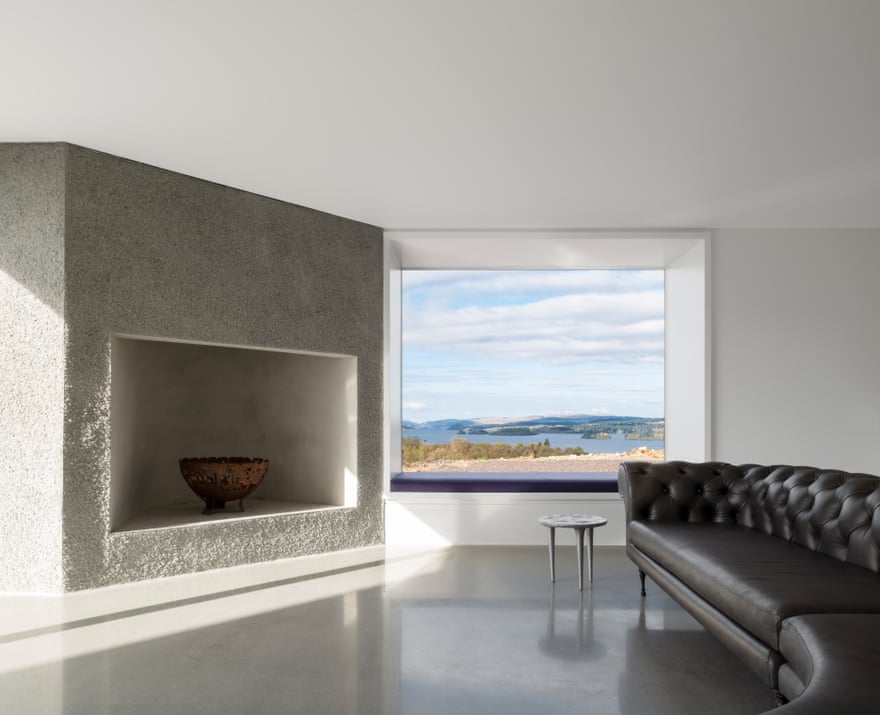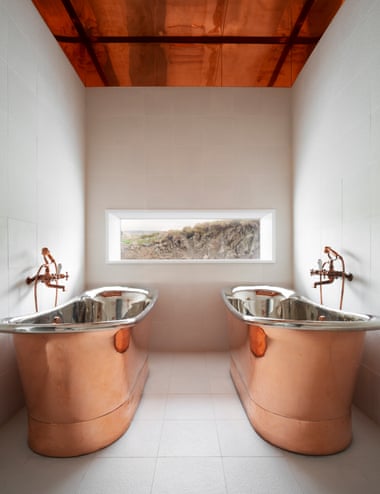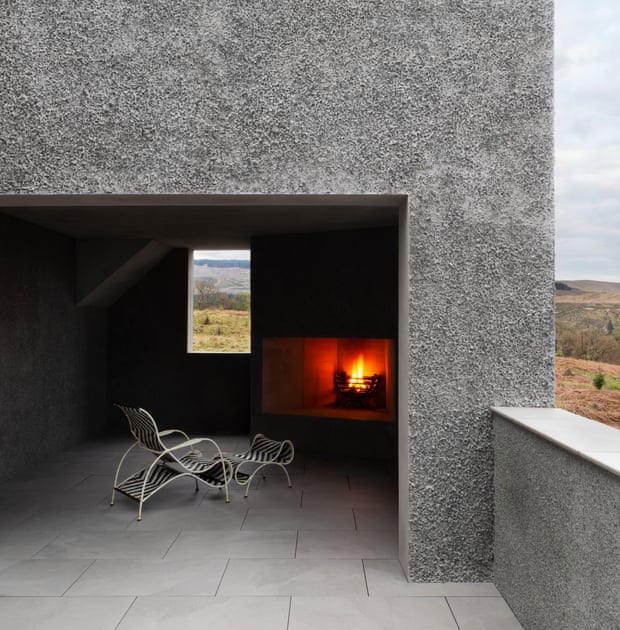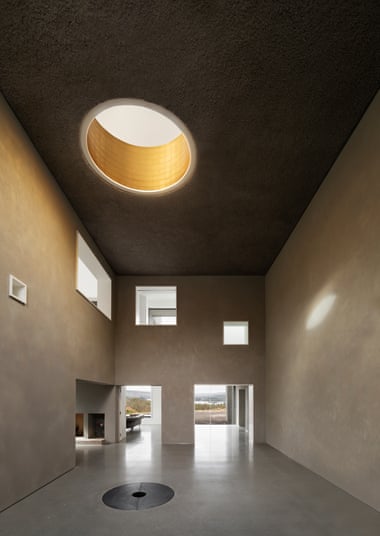It’s a sunny evening on the bonny banks of Loch Awe, deep in the Scottish Highlands, and something is sparkling behind the trees. Up a winding dirt track, past acres of densely planted pines, we come to a clearing where a huddle of chiselled gray blocks rise out of the landscape like a rocky outcrop, their abrasive sides glittering in the light, as if hewn from some crystalline mineral .
“It’s clad in crushed TV screens,” says Murray Kerr, the architect of one of the most unusual castles to be built in Argyll since the 1600s. “We were thinking of using greenish slate chips, so the building would look like a country gent in tweeds standing on the hill. But then we learned how much our client hates televisions, so this seemed like the perfect material.”
From a distance it looks like pebbledash, or harling as it’s called here. But as you approach the monolithic gray mass, its walls turn out to be covered in chunky glass nuggets, which have been recycled from old cathode-ray tube screens. It looks like something that has been mined from some future geological seam of electronic waste, precious sediment from the Anthropocene epoch.
It is one of many quirky details to be found in this sprawling 650 square meter home, which has been designed like a physical autobiography of the clients, David and Margaret, who preside over a clan of six children and six grandchildren. “It might seem extravagant to have a house of this size,” says David, a financial adviser, as he shows me around the seven en suite bedrooms, one of which has been designed as a dormitory for the grandkids, with eight bunk beds. “But we regularly fill it.”

Like most castles, it’s been a long time in the making. The couple, who have lived in Quarrier’s Village near Glasgow for years, acquired the 40-hectare (100-acre) site in 2007 for £250,000 after seeing it advertised in their local paper’s property supplement. It was former Forestry Commission land, with planning permission for a small log cabin. “They came to me with a picture of a baronial palace,” says Kerr. “They wanted a 12,000 sq ft house with a big basement for parties and a room for an 18-foot Christmas tree. And it had to be symmetrical.”
Kerr’s practice, Denizen Works, is not the first place you might look for a neo-baronial mansion. But he had come recommended by two friends, based on the characterful modern house he designed for his parents on the Isle of Tiree in the Hebrides. A series of barrel-vaulted rooms built on the ruins of a farmstead, it scooped Grand Designs Home of the Year in 2014. “We started by talking through the history of Scottish architecture,” says Kerr, “from iron-age brochs [drystone roundhouses] and defensive tower-houses, to baronial piles and Charles Rennie Mackintosh. Eight years later, they’ve got the most asymmetrical house possible, half the size, with no basement.”

It is a stark arrival, but the building channels a rugged Highland spirit that somehow feels in tune with the place. It stands with a tough, defensive air, rising above the loch like a fortified bastion, as if ready to fend off marauding clans. From the west, you can see tower-house echoes in the form of a stocky corner tower that rises to 10 meters (counterintuitively housing a cinema room at the top), while there are further castle allusions in the arrow-slit windows and deep chamfered openings chiselled into the walls.
The insides of the cuts, sliced with scalpel precision, are rendered with smaller chunks of glass, as if revealing a softer inner matter. Although it was built with a prefab timber frame, then wrapped with breeze blocks, Kerr describes the form as being “carved from a solid mass”, citing the Basque artist Eduardo Chillida, whose cubic marble sculptures provided inspiration for the cut-away sections. From the south, the house is a more low-slung affair, hunkered in the landscape, with a wing of bedrooms sloping down to the right, where a lochan, or small loch, is planted with reed beds to filter wastewater from the septic tank .
The building is cleverly positioned to be all but invisible from the surroundings, but it has nevertheless come as a shock to some. When its renderings were first published in the local press, readers didn’t hold back. “Looks like a muckle brute of a thing. Confused and lumpen,” wrote one. “It all looks a bit Atlantic Wall c.1944,” said another. “I’m all for modern architecture,” someone wrote on a local Facebook group“but this looks like something my wee boy created in Minecraft.”

Kerr was undeterred. “It’s good that it provoked a healthy debate,” he says, adding that the house on Tiree prompted a similar reaction at first. David agrees: “We didn’t design it to impress anyone else. It’s what we want.”
Their tastes are certainly singular, as the interior reveals. Along with the hatred of televisions, the couple have a disdain for fitted kitchens, too. The main kitchen features nothing but a gigantic eight-door Aga, positioned against a polished stainless steel wall, a table and a silver-painted grocery cupboard. The functional elements – sink, dishwasher, sideboards – are corralled into a tiny galley off to the side, while the fridge-freezer has been banished to a utility room on the other side of the house entirely. Fetching the milk for a cuppa is good for the step count, at least.
At the heart of the house is a grand central hall, rising to almost six meters. It is a theatrical space, its walls dotted with irregular windows that give views from the landing above, including a tiny postage stamp opening at child-height. “The kids love tearing around,” says David, adding that the house’s two staircases create a kind of circular promenade.

True to the brief, the main reason for the room’s vast height is to accommodate a giant Christmas tree – felled from the woodland each year and fixed in a dedicated sunken hole in the floor (soon to be topped by a decorative bronze manhole cover). A corresponding oculus in the ceiling, lined with gold leaf, casts warm light into the great chamber, where the walls are covered with an earthy clay rendering, mixed with specks of golden mica that give off a subtle shimmer.
The polished concrete floors also contain tiny fragments of mirror, bringing the crystalline sparkle of the facades inside, even on overcast days. It is a glittering prelude for the blingiest room of all, still to be fitted out: a shrine to whiskey, with a sunken bar entirely lined with polished copper. “Rosebank is my favourite,” says David, referring to the Lowland single malt distillery that closed in 1993 (although is set to reopen next year). “Something appeals to me that each time you drink a bottle, there’s one less left in the world.”
The couple’s rarefied tastes also extend to furniture. Some of the rooms were specifically designed around pieces commissioned from Southern Guild, a boutique “collectible design” gallery in Cape Town, South Africa. The soaring barrel-vaulted dining room, for example, had to house a four-metre black steel table, with a view of the loch. It is illuminated by an imposing black ash chandelierwith long movable spokes that recall the kind of crossed swords or deer antlers you might find in a baronial castle hall.
Similarly, the living room was designed around a large leather L-shaped sofa, facing not a TV but a big open fireplace – one of four hearts that dot the house. Another fireplace can be found outside, creating a cozy nook on the first floor terrace, half under cover, so you can keep warm while watching the “dreich” weather roll in off the loch.

The bathrooms continue the polished copper theme, including one with a pair of bathtubs side by side – intended to be romantic, but mainly enjoyed by the grandchildren, who love splashing about while looking at their reflections in the mirrored copper ceiling. Further autobiographical touches come in little seating nooks throughout the house, upholstered in purple leather from the Muirhead tannery (purveyors of leather to the House of Lords and Concorde).
The leather even extends to the ceiling of the library, where volumes include Donald Trump’s How to Get Rich, alongside a Winnie-the-Pooh book, Return to the Hundred Acre Wood – after which the property is named. But all is not what it seems. Push the book’s spine and, in a surprise moment of Scooby-Doo slapstick, the whole bookcase pivots to reveal a study hidden behind.
In a way, it sums up the attitude of the whole project: this house is a deeply idiosyncratic reflection of the clients, wrought with Highland heft on the outside, shielding a wry sense of fun, decadence and mischief within. Just try not to get lost on your way to the fridge.